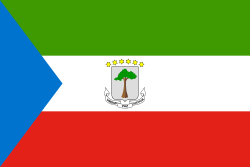Flag of Equatorial Guinea

 Flag ratio: 2:3
Flag ratio: 2:3The flag of Equatorial Guinea was adopted on August 21, 1979.
Features and symbolism
The flag is a horizontal tricolor, with green, white and red stripes and a blue triangle at the hoist.
- Green symbolizes the natural resources and jungles of the country.
- Blue symbolizes the sea, which connects the main country with the islands.
- White symbolizes peace.
- Red symbolizes the fight for independence.
History
The flag was first flown on the day of independence, October 12, 1968, and it showed the national emblem in the center. However, in 1972, during the regime of Francisco Nguema, a different national emblem appeared on the flag.[1] The original coat of arms was restored after Nguema was deposed in August 1979. The arms consists of a silver shield with a silk-cotton tree, which was derived from the arms of Rio Muni. Above the shield is an arc of 6 six-pointed yellow stars, that represent Rio Muni and the offshore islands. Beneath the shield is a silver scroll with the national motto, Unidad, Paz, Justicia ("Unity, Peace, Justice").
